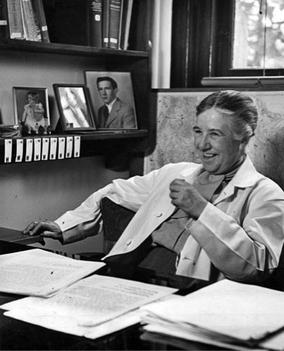Edith A. Roberts facts for kids
Edith Adelaide Roberts (1881–1977) was an amazing American scientist who studied plants. She was a botanist, which means she was an expert in plants. Edith Roberts was a pioneer in two important areas: plant physiology and plant ecology.
Plant physiology is about how plants work, like how they grow and get food. Plant ecology is about how plants live together and interact with their environment.
Edith Roberts did many cool things. She created the first outdoor lab in the U.S. where scientists could study plants in nature. She also helped people learn about natural landscaping, which means using plants that naturally grow in an area. Plus, she proved that plants are a super important source of vitamin A.
Contents
Becoming a Plant Scientist
Edith A. Roberts was born on April 28, 1881. She grew up on a farm in Rollinsford, New Hampshire. This early life probably sparked her interest in plants!
She went to college and earned her first degree from Smith College in 1905. Later, she got her Master's degree from the University of Chicago in 1911. Her advanced studies focused on how plants function.
Helping During World War I
From 1915 to 1917, Roberts taught at Mount Holyoke College. After that, she joined the United States Department of Agriculture (USDA). Her job was very important during World War I.
Many men were away fighting, so women had to manage farms. Edith traveled to all 48 states at the time. She taught women how to take care of farms and grow crops. She believed that knowing about plants was "basic to living" for everyone.
Teaching at Vassar College
After her work with the USDA, Roberts became a professor at Vassar College in 1919. By 1921, she was a full professor and led the Plant Science Department.
Her colleagues respected her a lot for her research. She studied how plants grow, how to grow native plants, and how seeds sprout. She was also a member of several important science groups, like the Botanical Society of America.
The First Outdoor Plant Lab
Edith Roberts was a leader in the new field of plant ecology. In 1920, Vassar College gave her four acres of land. She used this land to create the first outdoor botanical laboratory in the United States!
This special lab was in Dutchess County, New York. Roberts wanted to arrange plants there just as they would grow in nature. She made sure they had the right soil and conditions.
The college didn't give her much money for the lab. So, Edith often paid for it herself by giving lectures. Over time, her outdoor lab grew to have 2,000 different kinds of native plants!
Natural Landscaping Ideas
Edith Roberts worked with Elsa Rehmann, a landscape architect at Vassar. Rehmann used Roberts' plant research to create new ideas for garden design.
They wrote articles for House Beautiful magazine. Then, in 1929, they published a book called American Plants for American Gardens. This book helped people understand the benefits of using native plants in their yards. They were early supporters of natural landscaping.
In 1935, Roberts also wrote a book called American Ferns: How to Know, Grow and Use Them.
Plants as Vitamin Sources
After retiring from Vassar College in 1948, Roberts continued her research. She became a guest scientist at the Massachusetts Institute of Technology (MIT).
At MIT, she worked with the food technology department. She researched how different plants could be sources of vitamins. In 1948, she shared her findings with another scientist, Mildred Southwick. They showed that vitamin A could be found in young green and yellow parts of plants. Before this, many people thought vitamin A mainly came from fish liver oils.
Her Lasting Impact
After Edith Roberts retired, her outdoor ecological laboratory was cared for a few more years. But sadly, it was later forgotten. By the 1960s, it was abandoned. Her books also went out of print. Edith Roberts passed away in March 1977.
However, her legacy was not lost! In the 1990s, another Vassar professor, Margaret Ronsheim, rediscovered the remains of the lab. Now, the laboratory is being rebuilt. This means Edith Roberts' important work continues to inspire new generations of plant scientists!


